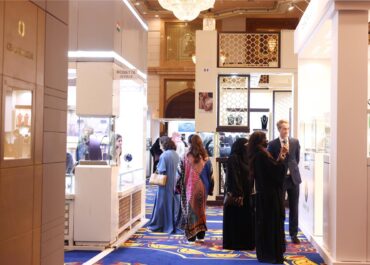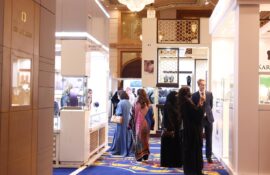Stephen Jones might not need an introduction, but he certainly deserves one. Fashion’s favourite, and most prolific, milliner is known for both his eponymous line, together with an A-Z of designer collaborations, from Alaïa to Comme des Garçons, and Dior to Marc Jacobs.

Born in 1957, Jones graduated from Saint Martin’s School of Art in 1979, starting his millinery career by making hats for friends at a time when London was the centre for creativity and iconoclastic fashion ideas. He made hats for Boy George, Spandau Ballet, and Grace Jones, and by 1980 was sufficiently established to open his own shop. As his reputation and clientele steadily grew, he was invited to represent Britain in fashion shows in New York, Montreal, Helsinki, and Tokyo, making him known today as the first designer to bring millinery into the forefront of the modern fashion world, with some of his most celebrated millinery being for Christian Dior throughout the years.
The legendary milliner, whose designs have adorned the heads of celebrities and royals around the globe for nearly four decades, is known for his bold, imaginative approach to design. Here, the Cheshire-born designer talks to us about his most memorable designs, and the rules of etiquette for wearing a hat at a wedding.

How did you get into millinery?
I got into Millinery because I was a very bad fashion student, and when I was at college at Saint Martins, my tailoring tutor told me that unless I got extra help in my first year of college, I was going to fail the end of the first year. He owned a Couture house, where I went as a tailoring intern and then changed to Millinery.
Do you remember the first hat that you ever designed?
The first hat I ever designed was in black towelling with red tulle, but I never made it. The first I actually made was made with plastic roses and my sister’s old blouse.
What has been the craziest and most alternative hat that you have created?
I think the craziest hat I ever made was for design duo Basso and Brooke, when it had dry ice in it, so the steam came down the models face as she walked down the catwalk, but in fact last week I made a hat for British designer John Skelton in London for his Autumn Winter 2017 show, which had red melted candles.

What appeals to you about designing hats rather than clothing?
Because the head is the dot on the ‘I’ and the cherry on the cake, and it’s how we communicate.

Who is your muse when designing your hats, and what inspires you?
It is very difficult to have only one muse, because everything would be designed just to suit her or him, I like to design for a variety of muses even though they only exist in my head.
In your opinion, what is key to creating the perfect hat?
Confidence!
Do you feel a hat changes the identity of the wearer, or rather enforces their identity?
A hat can be interpreted in both ways, sometimes it’s really a reflection of their character, but often it’s a wonderful disguise too.
Can anyone where a hat, and at any time?
Anybody can wear a hat and at any time, whether they’re male or female. It’s just they have to know what the right hat is, and most people are not aware of the many different hats that can be worn. It often only doesn’t need to be something complicated, it can actually be something quite simple, which says just enough but not too much.
Do you feel more empowered when you are wearing a hat?
No, I feel that it’s part of my persona, and I love the accent that it brings to my silhouette and my personality.
What is your favourite style of hat to wear?
A beret, the t-shirts of hats.
Is it true that you have the perfect sample size head?
A long time ago when I had hair, my head was too big to try my hats on, now I don’t so it’s much easier.
How does it feel to be such a notable ambassador for millinery?
It’s an honour because Milliners around the world are very creative people, who very often struggle to be recognised, and I am very happy to use my power and position to show the world their fascinating work.
How important do you feel millinery is to completing a fashion collection?
For a fashion collection, it’s nice to have something that will coordinate with the rest of the look and will help emphasise the idea. For a fashion show it certainly turns up the volume on whatever you’re showing, and adds individuality and personality, not only to the collection itself but in comparison to other designer’s collections.
Tell us about how hats are making a comeback in the world of fashion.
Many designers around the world are seeing hats as a way to make their look more identifiable. In a world where so many fashion images are seen on a 10-centimetre phone screen, a hat is a very obvious way of creating a distinct look. A black on black print could never be seen on a cell phone.
What does a hat do that clothes can’t?
Make you taller, emotionally, and physically.
Tell us about the first designers you collaborated with on their fashion shows.
The first designers I collaborated with in England were Zandra Rhodes and Jasper Conran. I knew Zandra as a friend, and she asked me to create fantasy headgear to compliment her very thematic collections. For Jasper Conran, I made very chic restrained felt hats, reminiscent of the Pope’s. Of course, my life changed completely when I went to Paris, and started to work with designers such as Jean Paul Gaultier, Thierry Mugler and Comme des Garçons.
What have been your most memorable collaborations?
I worked for a very long time with the designer Claude Montana, both with his own collection and for Lanvin. Working with Marc Jacobs has also been extraordinary because of his encyclopaedic knowledge of fashion. But my most well-known, and the collaboration closest to my heart, has been with John Galliano, both with his own label, and also with Dior, which continues to this day with the ever-inventive Maria Grazia Chiuri.
Tell us about designing for Dior at such an iconic time for the House, as Maria Grazia Chiuri took the helm.
I am well versed in the language of Dior, and it has been fascinating for me to hear somebody interpreting it in a completely new way. The fact that she is a woman, is not so important to me, but I found her distinct point of view of fantasy and function extremely innovative within contemporary fashion.
Your first collaboration with Dior was over 20 years ago, with so much change at the house in-between, what is your wildest or proudest memory?
That I am still there! Every day when I walk in there, I am amazed because this is the centre of the world of fashion, there is nowhere else.

How important is the role of hats at weddings?
To decorate yourself or to make yourself more splendid is essential for weddings, whatever the religion is, and whether you are a guest at an evening western wedding in America wearing a fascinator, or a day time wedding in Britain wearing a wide-brimmed hat. Of course, at a wedding in the Middle East, the bride looks beyond spectacular, and especially through my work with Dior, we have created many bridal veils, for those beautiful women, but for me it is wonderful when the guests also do not, in my mind, forget to decorate their heads.
As a wedding guest, what is appropriate hat etiquette?
That it’s all about the bride, and not about you, but at the same time you should show that you enjoy life and enjoy dressing, so something which is high spirited, but not too showy. There is very much a difference between the hat appropriate for a wedding, versus the hat appropriate for a race meeting.
How do you choose between a hat or fascinator, and what do you prefer?
A fascinator is normally best with dresses or evening tailoring, and a hat is better with architectural dresses or day time tailoring.
Are hats just confined to the guests, or is this something that the bride can play with too?
Absolutely the bride can play with the idea of a hat, whether it’s a tiara, a garland, or flowers, around the world every bride’s head is decorated. We communicate through our heads, so it would seem strange if she went unadorned.
What is the most iconic hat of all time?
Queen Elizabeth’s Crown!
By Eliza Scarborough















